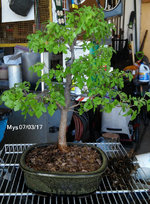Tulsabonsigh
Shohin
- Messages
- 259
- Reaction score
- 177
Siberian Elm.
Amur Maple.
The only conifer I can find to work relatively well so far is the J. Virginia.
AKA J.Crack.
Chicagoland.
This is cuz I found this thing, View attachment 80418
Knows my winter.
And the Hokkaido I can't protect is Probly gonna be a 26 dollar loss.
Gotta start saving that for nice stuff!
Sorce
hey sorce; what plant is in this image!? I need one!



